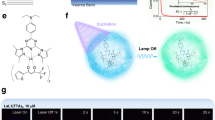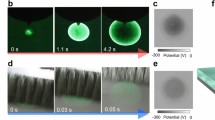Abstract
THE emission of light which accompanies mechanical deformation or fracture of certain crystalline compounds is designated as triboluminescence. Stranski et al.1,2 investigated some 1,700 organic and inorganic substances and found 356 of them to exhibit triboluminescence. Special impact mechanisms and complete darkness are required to observe the triboluminescent emission from all previously reported triboluminescent materials. In addition, a number of these compounds showed detectable triboluminescence only in a small range of environmental gas pressure and low temperature. Triboluminescence emission from europium tetrakis (dibenzoylmethide)-triethylammonium (EuD4TEA) is clearly visible in broad daylight at room temperature when crystals are broken with a glass rod or spatula in a test-tube. Apparently this property is common to most europium tetrakis (dibenzoylmethide) complexes which contain a variety of organic cations derived from aliphatic amines. The relative intensity of triboluminescent emission, however, varies significantly with the nature of the substituted ammonium ion, the method of preparation, average size of crystals, and recrystallization solvent.
This is a preview of subscription content, access via your institution
Access options
Subscribe to this journal
Receive 51 print issues and online access
$199.00 per year
only $3.90 per issue
Buy this article
- Purchase on Springer Link
- Instant access to full article PDF
Prices may be subject to local taxes which are calculated during checkout
Similar content being viewed by others
References
Wolff, Von G., Gross, G., and Stranski, N., Z. Elektrochem., 56, 420 (1952).
Wolff, Von G., Gross, G., and Stranski, N., Z. Elektrochem., 59, 341 (1955).
Filipescu, N., Sager, W. F., and Serafin, F. A., J. Phys. Chem., 68, 3324 (1964).
Filipescu, N., Sager, W. F., and Serafin, F. A., J. Phys. Chem., 69, 1092 (1965).
Bjorklund, S., Filipescu, N., McAvoy, N., and Degnan, J., J. Chem. Phys. (in the press).
McAvoy, N., Filipescu, N., and Kagan, M. R., J. Phys. Chem. Solids, 25, 461 (1964).
Author information
Authors and Affiliations
Rights and permissions
About this article
Cite this article
HURT, C., MCAVOY, N., BJORKLUND, S. et al. High Intensity Triboluminescence in Europium Tetrakis (Dibenzoylmethide)-triethylammonium. Nature 212, 179–180 (1966). https://doi.org/10.1038/212179b0
Issue Date:
DOI: https://doi.org/10.1038/212179b0
This article is cited by
-
Mechanoluminescence of metal complexes: Progress and applications
Journal of Central South University (2023)
-
Lanthanide-doped metal-organic frameworks with multicolor mechanoluminescence
Science China Materials (2021)
-
The initial attempt to reveal the emission processes of both mechanoluminescence and room temperature phosphorescence with the aid of circular dichroism in solid state
Science China Chemistry (2021)
-
Effective photosensitized, electrosensitized, and mechanosensitized luminescence of lanthanide complexes
NPG Asia Materials (2018)
-
Recent advances in mechanoluminescent polymers
Science China Materials (2016)
Comments
By submitting a comment you agree to abide by our Terms and Community Guidelines. If you find something abusive or that does not comply with our terms or guidelines please flag it as inappropriate.



